Posts Tagged: flowers
Summertime
It’s such a pleasure spending time in the garden, especially this time of year. Even with our erratic weather, we have color and life everywhere. The garden is abundant with vegetables and flowers. We have been busy the past 2 months harvesting cherries, followed by peaches. A couple of days ago, I pulled the yellow onions, cleaned and trimmed them for storage. The ‘Big Boy’ and ‘Juliet’ tomatoes are providing us with tomato sandwiches and salads. The zucchini is trying it’s best to hide from our searching eyes. The last one was about a foot long (oops). Eating outdoors just about daily is the best summertime treat and a relaxing way to catch up on our daily activities. Listening to the splashing of our water features, watching the bees and hummingbirds-zipping back and forth. What a treat. The dahlias are blooming in several corners of the yard and these blooms have been cut and placed in a vase gracing our kitchen island. The begonias, in pots and hanging baskets are glorious. As busy as we are each day, enjoying the fruits of our labor, is the best feeling. There is no better time than “the good ole summertime” and right now we’re enjoying every minute of it before it’s over.
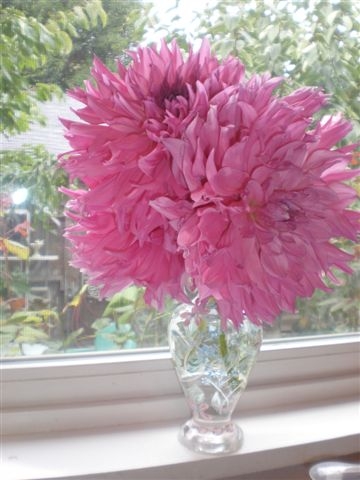
Pink dahlia. (photo by Sharon Rico)
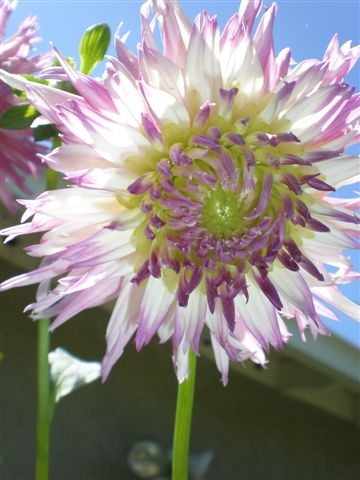
Lavender and white dahlia.
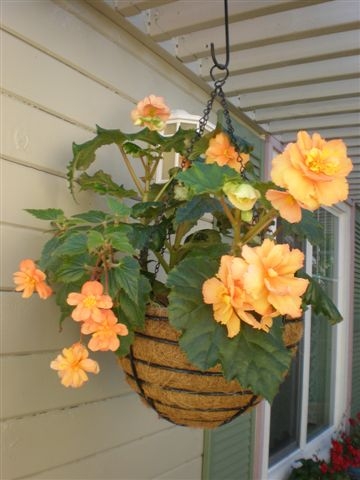
Big beautiful begonia.
Glow in the Dark White Garden
It’s a pleasure to look out my upstairs bedroom window on dark summer nights. I look down on two beautiful white rose bushes growing in my neighbor’s garden across the street. Any time there’s a moon they become luminous. They truly glow in the dark!
Anyone who has access to the UCD Arboretum on a moonlit summer night can share my neighborhood experience on a much larger scale. A walk through the “ Carolee Shields White Garden” near the west end of the arboretum is a magical experience, made more so when there’s a full moon. Designed in the style of a Japanese Moon Garden it’s also the location of a lovely gazebo, popular for weddings.
White flowers of many varieties bloom in all seasons. They’re beautiful in the daylight too, of course, but moonlight sets the White Garden apart from all the other themed Arboretum landscapes. Its ethereal loveliness is worth the trip to the UCD campus.
It’s a bit of a walk out there, depending on where you leave your car, and somewhat remote from main campus areas. A flashlight and a companion are necessities, and selecting a night when the moon is expected to be especially bright is a plus!
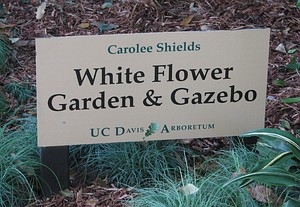
UC Davis Arboretum White Flower Garden sign. (photo by Marime Burton)
Make Friends with Your Clay
Soil texture is an important factor in determining the success of your gardening venture. Texture is determined by the proportions of sand, silt, and clay minerals of your soil. Clay, predominate in this geographic area, is very fine-textured, and referred to as a 'heavy soil'. Clay has one thousand times more surface area per gram than silt, and almost a million times more surface than course sand.
Sandy or silt loam is said to be the best soil for home gardening, as this provides a mixture that retains water and is able to percolate and infiltrate. Clay can become hard as rock and does not drain well.
Several things can be done to deal with our clay. One is to add raised beds to your garden, bringing in good loamy soil from a reputable source, and placing it on top of existing soil, where you want to plant.
Secondly, you can amend your existing clay soil with organic materials. Two common methods for doing this are: one, to add compost to soil and work it in. This is best done with hoes and or shovels, as tilling can destroy living organisms, such as worms, which are most beneficial to the garden. Severely compacted soil may require tilling. Of so, till down 10-12" deep. Allow soil to dry out--two to three days prior to adding amendments. Remove rocks, roots and debris. Break up any large clods with a hoe. Place two to three inches of compost on the area and work in. Do not do this when the soil is too wet or to dry. Peat moss would work as an amendment, but is expensive. Compost and well rotted manure both are organic and ideal for garden plots. A second method is to cover the area with 4-6" of rotten hay or straw and let it sit for up to a year, as this will slowly break down the soil. Easier on the back but takes much more time.
A third approach is to accept the clay and plant items that do well in that texture of soil. Here is a partial list of some flowers that actually will do fine: Black-eyed Susan, bluestar, aster, baptisia, coreopsis, purple cone flower, sea holly, perennial geranium, false sunflower, daylily, coral bells, blazing star (great for a butterfly garden), bee balm, Russian sage, yarrow, and switch grass, said to actually thrive in moist or dry clay.
So clay does not have to be a gardener's four letter word like mole, weed, or mold. Work with it, amend it, accept it.
The Ladies Are Almost Here!
I'm referring to the sweet, pink Amaryllis belladonna bulbs in my garden, also commonly referred to as "Naked Ladies." In case you're not familiar, they are the stalk topped by several clusters of pink trumpet-shaped flowers. What makes them so striking are the naked stalks with no leaves, just flowers, thus the nickname "Naked Ladies."
I love that they have a lovely fragrance. It's also nice to know that they do just as beautifully in our hot Mediterranean climate as they do on the foggy, cool northern California coast . As long as they are treated to warm, dry summers in well-drained soil, they'll do well for you for a very long time.
My first batch of these bulbs (about 5 bulbs) were given to me about 14 years ago in a brown paper bag by my Uncle Bob. He passed away several years ago, and his wife, my aunt, just recently went on to be with him, so this years bloom is bittersweet to see. Anyway, in the years since, I've divided the bulbs a few times (they don't appreciate being disturbed, especially at the wrong time), so that now I have these little beauties popping up all over my backyard. They are a gift that keeps on giving, year after year.
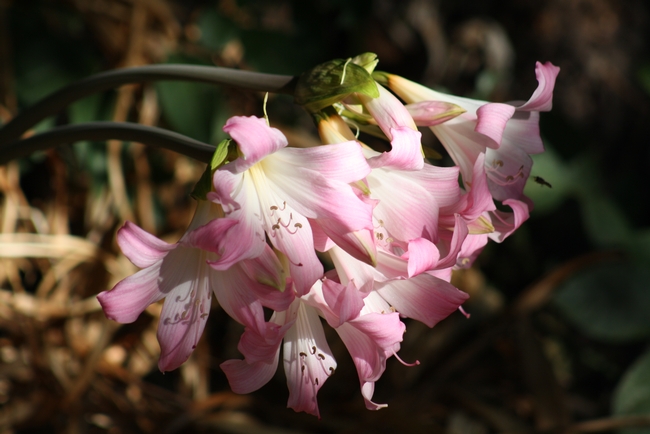
The Naked Ladies. (photo by Jennifer Baumbach)
Limonium
One of my favorite plants is Limonium, aka statice or sea lavender. It has solved a problem area in my front yard.
Previously, The edge of the front lawn sloped down with a drop of about 12 or so inches from the cement steps up to the front of the house. The edge of the grass showed the roots of the turf and was frequently "burned" by the edge trimmer or lawn mower. This space was like a "no man's land" with the bare edge of concrete offering anything but curb appeal.
This part of the garden receives full exposure to the wind and sun. I choose to try some statice as a border alongside this walkway. I have seen this hardy plant survive and even thrive in similar conditions, no doubt the common name "sea lavender" was earned by the many gardens it has inhabited in the many gardens with a marine influence.
The statice has been in place now about five years. Snails are attracted by the leaves but the plants are so vigorous the damage is minimal. I trim the flower stalks occasionally when they fade. Soon there after new shoots will appear to take their place. My garden reference books say the "perezii" variety will bloom over the long summer but my experience is an almost continuous bloom through out the year. The flower clusters can grow up to 3 feet across and consist of a rich purple calyx with a tiny white corolla. The blooms dry very easily by hanging upside down until dry but I find they can be pretty messy. Since these plants bloom continuously, I just cut the fresh stalks when needed. Very little water is needed for these established plants and I do not add any fertilizer at all.
Enjoy this very giving plant in your garden with very little effort on your part.

Sea lavender. (photo by Trisha Rose)

